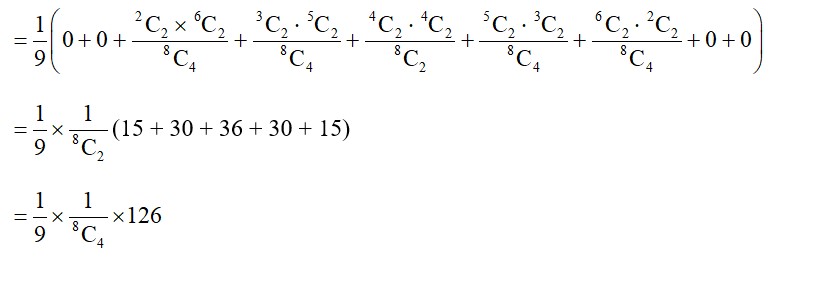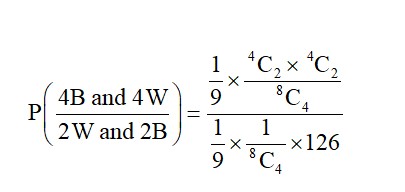81. An urn contains 25 balls of which 10 balls bear a mark ‘X’ and the remaining 15 bear a mark ‘Y’. A ball is drawn at random from the urn, its mark noted down and it is replaced. If 6 balls are drawn in this way, find the probability that:
(i) All will bear ‘X’ mark.
(ii) Not more than 2 will bear ‘Y’ mark.
(iii) At least one ball will bear ‘Y’ mark.
(iv) The number of balls with ‘X’ mark and ‘Y’ mark will be equal.
81. An urn contains 25 balls of which 10 balls bear a mark ‘X’ and the remaining 15 bear a mark ‘Y’. A ball is drawn at random from the urn, its mark noted down and it is replaced. If 6 balls are drawn in this way, find the probability that:
(i) All will bear ‘X’ mark.
(ii) Not more than 2 will bear ‘Y’ mark.
(iii) At least one ball will bear ‘Y’ mark.
(iv) The number of balls with ‘X’ mark and ‘Y’ mark will be equal.
-
1 Answer
-
81. Total number of balls in the urn = 25
Balls bearing mark ‘X’ = 10
Balls bearing mark ‘Y’ = 15
p = P (ball bearing mark ‘X’) =10/25 = 2/5
q = P (ball bearing mark ‘Y’) =15/25 = 3/5
Six balls are drawn with replacement. Therefore, the number of trials are Bernoulli trials.
Let Z be the random variable that represents the number of balls with ‘Y’ mark on them in the trials.
Clearly, Z has a binomial distribution with n = 6 and p =2/5.
P (all will bear ‘X’ mark)
P (not more than 2 bear ‘Y’ mark)
P (at least one ball bears
...more
Similar Questions for you
P (2 obtained on even numbered toss) = k (let)
P (2) =
P (
If x = 0, y = 6, 7, 8, 9, 10
If x = 1, y = 7, 8, 9, 10
If x = 2, y = 8, 9, 10
If x = 3, y = 9, 10
If x = 4, y = 10
If x = 5, y = no possible value
Total possible ways = (5 + 4 + 3 + 2 + 1) * 2
= 30
Required probability
P (2W and 2B) = P (2B, 6W) × P (2W and 2B)
+ P (3B, 5W) × P (2W and 2B)
+ P (4B, 4W) × P (2W and 2B)
+ P (5B, 3W) × P (2W and 2B)
+ P (6B, 2W) × P (2W and 2B)
(15 + 30 + 36 + 30 + 15)
Let probability of tail is
⇒ Probability of getting head =
∴ Probability of getting 2 heads and 1 tail
ax2 + bx + c = 0
D = b2 – 4ac
D = 0
b2 – 4ac = 0
b2 = 4ac
(i) AC = 1, b = 2 (1, 2, 1) is one way
(ii) AC = 4, b = 4
(iii) AC = 9, b = 6, a = 3, c = 3 is one way
1 + 3 + 1 = 5 way
Required probability =
Taking an Exam? Selecting a College?
Get authentic answers from experts, students and alumni that you won't find anywhere else
Sign Up on ShikshaOn Shiksha, get access to
- 65k Colleges
- 1.2k Exams
- 679k Reviews
- 1800k Answers


